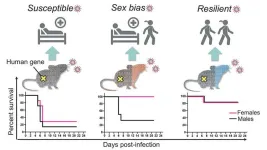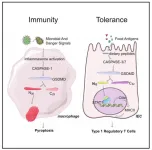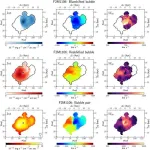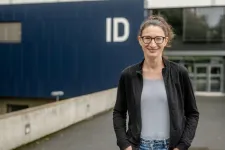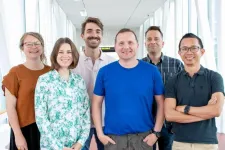USTC develops new catalysts for CO2 electroreduction
2023-08-11
(Press-News.org) As a crucial part of Carbon Capture, Utilization, and Storage (CCUS) technology, CO2 reduction reaction (CO2RR) to carbon-based fuels and chemicals presents broad application prospects in renewable energy storage and CO2 negative emission. Recently, a team led by Prof. SONG Li and Associate Researcher HE Qun from the National Synchrotron Radiation Laboratory of the University of Science and Technology of China (USTC) of the Chinese Academy of Sciences (CAS) put forth a novel understanding of the mechanism of CO2RR on the nickel (Ni) single-atomic sites. Their study, titled "Asymmetric Dinitrogen-Coordinated Nickel Single-Atomic Sites for Efficient CO2 Electroreduction", was published in Nature Communications on 24 June.
An ideal CO2RR catalyst requires low overpotential and high current density to products. However, former catalysts either are featured with high cost and low current density, such as gold (Au) and silver (Ag), usually exhibit much higher overpotentials than Au and Ag, such as Fe, Co, or Ni, limiting reaction efficiency. Therefore, it is imperative to develop overpotential low, high current density, abundant 3d metal-based catalysts to replace precious metal catalysts for CO2RR. To address those challenges, the researchers proposed an asymmetric dinitrogen-coordinated nickel single-atom catalyst (Ni-N-C). By utilizing the unsaturated and asymmetric characteristics of the sites, structural self-optimization during the electrochemical process is achieved, thereby enhancing the intrinsic activity of the sites in CO2RR.
In the study, the team designed and synthesized Ni-N-C featuring dinitrogen coordination (pyridinic and pyrrolic nitrogen) and then utilized it for CO2 electroreduction reactions in neutral and alkaline media. Synchrotron radiation X-ray absorption spectra and emission spectra revealed the local coordination structure of Ni sites in the catalyst. The electrochemical test results showed that the Ni-N-C catalyst could achieve very high electrochemical performance in both neutral (H-type cell) and alkaline (gas diffusion electrode, GDE) electrolytes. Especially in alkaline conditions, the catalyst could achieve a CO partial current density of 20.1 mA cmgeo-2 at -0.15 V vs. reversible hydrogen electrode (VRHE), Faraday efficiency of over 90% for CO in the potential range of -0.15 to -0.9 VRHE, and high turnover frequency (TOF) of over 274,000 site-1 h-1 at -1.0 VRHE, surpassing most reported catalysts.
This study offers a novel comprehension of the catalyst's role in the CO2 electroreduction reaction and promises to shed new light on future CO2 reduction technologies.
Jane FAN Qiong
Tel: +86-551-63607280
E-mail:englishnews@ustc.edu.cn
END
[Attachments] See images for this press release:
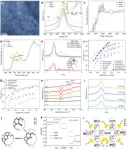
ELSE PRESS RELEASES FROM THIS DATE:
2023-08-11
Researchers at The Jackson Laboratory have created a panel of genetically diverse mice that accurately model the highly variable human response to SARS-CoV-2 infection. Together with collaborators at NIH’s Rocky Mountain Laboratories, the team uncovered differences in the innate immune and regulated proinflammatory responses, the timing and strength of which are associated with disease severity. Moving forward, the diverse mouse strains will allow scientists to model patient variation in COVID-19 ...
2023-08-11
A research team led by Prof. ZHU Shu from the University of Science and Technology of China (USTC) of the Chinese Academy of Sciences (CAS) illustrated the role of Gasdermin D (GSDMD) protein in immunity tolerance to food in the small intestine. The study was published in Cell.
GSDMD, an executioner protein of cell pyroptosis, has garnered widespread attention. When cells are stimulated by pathogen-associated molecular patterns (PAMPs) or damage-associated molecular patterns (DAMPs), the signaling receptors within the cells activate caspase-1/4/5/8/11, leading to the N-terminal cleavage of GSDMD and ...
2023-08-11
A team led by Prof. LIU Guilin and Prof. HE Zhicheng from the University of Science and Technology of China (USTC) of the Chinese Academy of Sciences (CAS) discovered superbubble pairs generated by quasar-driven outflows of three red quasars for the first time. This study was published in Science Advances.
The observed number of massive galaxies is significantly lower than the prediction of the current galaxy evolution theory, thus certain mechanism is needed to suppress star formation and modulate the growth of the galaxy. To bridge the gap between theory and observation, an outflow mechanism where a galaxy nucleus drives a massive amount of gas into intergalactic ...
2023-08-11
Prof. REN Baohua and his team from the School of Earth and Space Sciences, the University of Science and Technology of China (USTC) of the Chinese Academy of Sciences (CAS), uncovered the connection between Arctic daily warming and the equator region as well as Atlantic storms. The series of studies have been published in npj Climate and Atmospheric Science, Environmental Research Letters, and Advances in Atmospheric Sciences.
As one of the coldest places where the average winter temperature is -30℃, the Arctic temperature has reached the melting point several times, for instance, in late December 2015 and 2022. Those Artic daily warming events ...
2023-08-11
A research team led by Professor WANG Jian, the deputy chief designer of the Wide Field Survey Telescope(WFST)and a faculty member of the State Key Laboratory of Nuclear Detection and Nuclear Electronics of the School of Physics, University of Science and Technology of China (USTC) of the Chinese Academy of Sciences(CAS), carried out the key technology of the main focus camera. The results were published in IEEE Transactions on Instrumentation and Measurement in July ...
2023-08-11
The research team led by Prof. LIU Xianwei from the Department of Environmental Science and Engineering of University of Science and Technology of China (USTC) of the Chinese Academy of Science (CAS) has made progress in the dynamic imaging of interfacial electrochemistry. The results were published in Nature Communications under the title of "Dynamic Imaging of Interfacial Electrochemistry on Single Ag Nanowires by Azimuth-modulated Plasmonic Scattering ...
2023-08-11
A research team led by Prof. WU Dong from the University of Science and Technology of China (USTC) of the Chinese Academy of Sciences (CAS) proposed a femtosecond laser 2-in-1 writing multi-material processing strategy to fabricate micromachined joints composed of temperature-sensitive hydrogels and metal nanoparticles, and developed multi-jointed humanoid micromachines with multiple deformation modes (>10). The results were published in Nature Communications.
In recent years, femtosecond laser two-photon polymerization, as a true three-dimensional fabrication technique ...
2023-08-11
Lasers are an essential tool for materials processing. They can be used to cut, weld and remove material. A special kind of lasers known as femtosecond lasers can be used to create high-precision microstructures, such as those needed for smartphone displays and automotive technology. Professor Clara Saraceno from Ruhr University Bochum aims to introduce a cheaper and more efficient laser technology to the market. To this end, she is receiving a proof-of-concept grant amounting to 150,000 euros from the European Research ...
2023-08-11
A new study presents a promising treatment method for so-called fusion-driven cancers, which are currently often difficult to cure. These fusion-driven cancers are caused by an error in cell division that creates a fusion of different genes. This fusion causes the cancer and drives the uncontrolled cell growth.
Using the so-called molecular scissors CRISPR/Cas9, researchers from Aarhus University have developed a gene therapy that can stop cell division in a subtype of the aggressive blood cancer acute myeloid leukaemia (AML).
The study has just been published in the scientific journal Leukemia. Even though the ...
2023-08-11
A new study reports conclusive evidence for the breakdown of standard gravity in the low acceleration limit from a verifiable analysis of the orbital motions of long-period, widely separated, binary stars, usually referred to as wide binaries in astronomy and astrophysics. The study carried out by Kyu-Hyun Chae, professor of physics and astronomy at Sejong University in Seoul, used up to 26,500 wide binaries within 650 light years (LY) observed by European Space Agency’s Gaia space telescope. Kareem El-Badry, then at Harvard and now a faculty at ...
LAST 30 PRESS RELEASES:
[Press-News.org] USTC develops new catalysts for CO2 electroreduction

